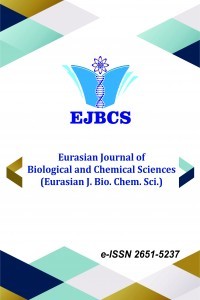Investigation of antioxidant properties of olive leave extracts from Hatay by different extraction methods
Investigation of antioxidant properties of olive leave extracts from Hatay by different extraction methods
Olive leaf, Antioxidant Activity Maceration, Soxhlet,
___
- Abaza L. Youssef N.B. Manai H. Haddada F.M. Methenni K. Zarrouk M. 2011. Chétoui olive leaf extracts: influence of the solvent type on phenolics and antioxidant activities. Grasas y Aceites. 62: 96-104.
- Aeschbach R. Halliwell B. Löliger J Aruoma OI. 1995. The characterization of antioxidants, Food and Chemical Toxicology. 1995; 33: 601-617.
- Atak Y. Gönenç A. Orman MN. Şimşek B. 2002. Lipid Peroxidation and Antioxidant Systems in Hemodialyzed Patients, Department of Biochemistry.31 (2): 88-96.
- Bayrak A. Kiralan M. Çalıkoğlu E. Kara H. 2010. Ege bölgesi zeytinyağlarının aroma profilleri ve bazı kalite özelliklerinin araştırılması. Ankara Üniversitesi Araştırma Projesi.
- Bouaziz,ü M. Feki I. Ayadi M. Jemai H. Sayadi S. 2010. Stability of Refined Olive Oil and Olive-Pomace Oil Added by Phenolic Compunds From Olive Leaves. Eur.J.Lipid Sci. Technol. 112, 894-905.
- Boudhrioua, N. Bahloul N. Slimen B.I. Kechaou N. 2009. Comparison on The Total Phenol Contents and The Color of Fresh and Infrared Dried Olive Leaves. Industrial Crops and Products. 29, 412-419.
- Cho W.Kim D.Lee H.Yean S.Lee C.Journal of Food Quality Evaluation of Effect of Extraction Solvent on Selected Properties of Olive Leaf Extract
- Çentinkaya and Kulak. 2006.Relatıonshıp Between Total Phenolıc, Total Flavonoıd and oleuropeın ın dıfferent aged olıve (olea europaea l.) cultıvar leaves
- Çetinkaya H. 2017. Bazı Zeytin Çeşidi Yapraklarındaki Flavanol Miktarına Ağaç Yaşı, Çeşit ve Sulamanın Etkisi. Kilis 7 Aralık Üniversitesi. Ziraat Fakültesi. Bahçe Bitkileri Bölümü. 79000 Kilis
- http://uzzk.org/Belgeler/2020_2021_TURKIYE_REKOLTE_RAPORU.pdf
- Erbay Z. And Icıer F. 2010. The Importance and Potential Uses of Olive Leaves
- Gutfınger. 1981. Polphenols in Olive Oils. JAOCS. 58(11): 966-968.
- Hansen M. 2002. “Olive Leaf Extract” Goldgolf Pty Publisher Australia. 3-10.
- Page L. 2002. “Olive Leaf Extract” in Healthy Healing, edited by Page L.G.(Traditional Wisdom, USA). 107.
- Prasatkumar M. Raja K. Vasanth K. Khusro A. SadhasivamS.Sahibzada M. Gawwad. Farraj D. Elshikh M.2021.Phytochemical screening and in vitro antibacterial, antioxidant,anti-inflammotory, anti-diabetic,and wound healing attributes of senna auriculata ) L.) Roxb.leaves
- Hansen R.E. Østergaard, H. Nørgaard, P. Wınther, J.R. 2007. Quantification of protein thiols and dithiols in the picomolar range using sodium borohydride and 4,4’- dithiodipyridine, Analytical Biochemistry. 363, 77-82.
- Jemai, H. EL Feki, A., Sayadi, S. 2009. Antidiabetic and Antioxidant Effect of Hydroxytyrosol and Oleuropein from Olive Leaves in Alloxan-Diabetic Rats. Journal Agricultural and Food Chemistry. 57, 8798-8804.
- Karakulak, Ş. 2009. Zeytin yapraklarından antiooksidan eldesinde mikrodalga ve etüv ile kurutmanın çözücü, sıcaklık ve zaman parametreleri uzerine etkisinin incelenmesi
- Khizrievaa. Borisenko S.N. Maksimenko E.V. Borisenko N.I. and Minkin V.I. 2021. Study of the Composition and Anti-Acetylcholinesterase Activity of Olive Leaf (Olea europea L.) Extracts Obtained in Subcritical Water
- García M. Prieto S. Valera M.Pancorbo A. Bravo A. Verardo V. and Caravaca A. 2022. Comparative Extraction of Phenolic Compounds from Olive Leaves Using a Sonotrode and an Ultrasonic Bath and the Evaluation of Both Antioxidant and Antimicrobial Activity
- Mourtzinos I. Salta F. Yannakopoulou K.Chiou A. Karathanos V. T. 2007. Encapsulation of olive leaf extract in β-cyclodextrin. J. of Agricultural and Food Chemistry. 55(20): 8088-094.
- Omar S. H. 2010. Oleuropein in Olive and its Pharmacological Effects, Sci Pha. 78: 133-154.
- Sevim D. Tuncay Ö. 2012. Ayvalık Ve Memecik Zeytin Çeşitlerinin Yaprağı ve meyvelerinin Toplam Fenolik Madde Miktarı Ve Antioksidan Aktiviteleri. Gıda. 2012. 37: 219-226.
- Thakur and Kumar.2021.Microclimatic Buffereing on Medicinal and Aromatic Plants:A review
- Yayın Aralığı: Yılda 2 Sayı
- Başlangıç: 2018
- Yayıncı: Muhammet DOĞAN
Biochemical Laboratory Findings on COVID-19 Patients: Pathogen-Disease Relationship
Aysel GÜVEN, Ertugrul ALLAHVERDİ, Tülay ALLAHVERDİ, Meriç ÇOLAK
Effects of different nitrogen sources on invertase production by Aspergillus niger
Özden CANLI TAŞAR, Gani Erhan TAŞAR
Thymoquinone Prevents Valproic Acid-Induced Nephrotoxicity in Rat Kidney
Sebile AZİRAK, Deniz TAŞTEMİR KORKMAZ, Sedat BİLGİÇ, Meltem ÖZGÖÇMEN, Mehmet Kaya ÖZER
Ayşen Yağmur KURŞUN, Burcin YALCİN, Merve GÜNEŞ, Ghada TAGORTİ, Bülent KAYA
SARS-COV-2 enfeksiyonu olan hastalarda laboratuvar parametrelerin prognoz değeri
Kübra DANIŞ, Buse Nur BİNGÖL, Gökhan KARS
